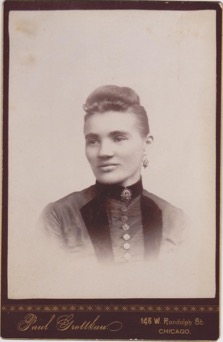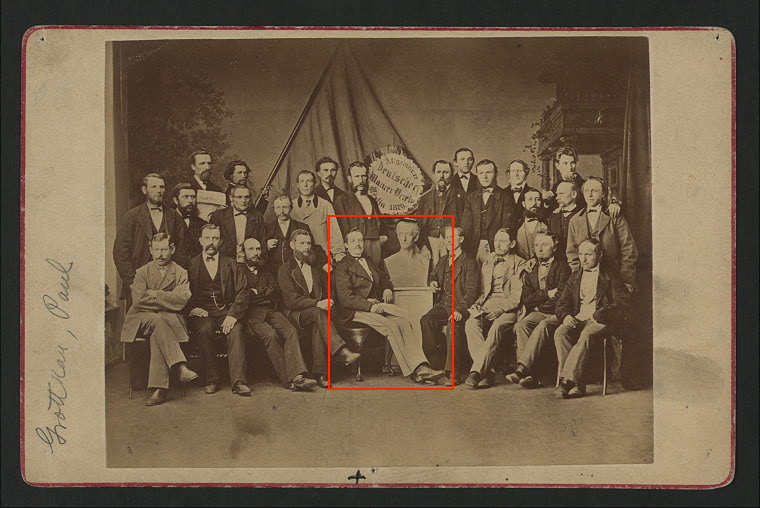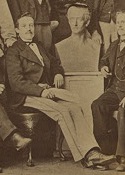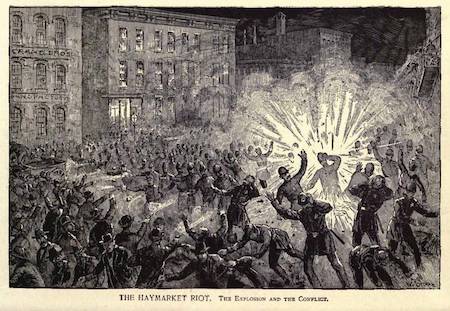 [Soon after I began publishing this blog in spring 2009, I began my reportage on the imminent dismantling and dispersal of the unique Polaroid Collection. In the process I discovered, unexpectedly, both my own penchant for longform cultural journalism and the suitability of blogware as a platform for same.
[Soon after I began publishing this blog in spring 2009, I began my reportage on the imminent dismantling and dispersal of the unique Polaroid Collection. In the process I discovered, unexpectedly, both my own penchant for longform cultural journalism and the suitability of blogware as a platform for same.
Since then I have regularly initiated extended series of posts on diverse subjects that fall into this blog’s broadly defined territory (“photography and related matters”). Most of those I’ve written myself, but at least one invited guest, Charles Herrick, has provided an extensive mini-series of his own as intermittent contributions to the blog’s longest-running undertaking, “Alternate History: Robert Capa on D-Day.”
That investigation added what we might call longform historical research to the blog’s repertoire. So when, several years ago, my friend and colleague Colleen Thornton introduced me to the research she had begun based on a 19th-century photograph she purchased on eBay, I offered her as much space as she needed at the blog for publication of her results.
Beginning below, the outcome of Thornton’s painstaking inquiry introduces to the medium’s history two extraordinary figures: a German-born 19th-century U.S.-based anarcho-socialist photographer, Paul Grottkau, and his subject, the African-American anarcho-socialist Lucy Parsons, widow of one of the men railroaded to public hanging in the prosecution of the suspects of the Chicago Haymarket Riot. In the cabinet portrait that Thornton discovered the destinies of these two notable left-wing figures intersect, as her essay makes clear.
Unlike the Capa D-Day project here at the blog, which functions as the running journal or diary of an ongoing investigation, Thornton offers a self-contained, persuasive, and compelling analysis, a prime example of what close attention to individual photographs can reveal. This is a first-rate work of scholarship, and a significant addition to the literature. It marks the blog’s first (but perhaps not last) publication of a fully resolved piece of research.
Thornton’s article as written comes in two parts. I will publish each part in three installments — Part I this week, Part II early in August. Click here for the second installment of Part I. — A.D.C.]
•
Paul Grottkau: Anarchist Photographer, Part I
by Colleen Thornton
•
Introduction
Who is the Mixed-Race Woman Photographed by the Anarchist Labor Leader and Photographer Paul Grottkau?
Portraiture is the most complex and, arguably, the most intimate form of artistic expression, chronicling a time-jumping journey of mutual perception, experience and truth-seeking that is perpetually conducted between the artist, the sitter, and the viewer. The example investigated here is a late 19th-century portrait photograph executed in the ubiquitous, formal three-quarter-view bust format.
![Cabinet card photographic portrait of a "mixed-race" lady, taken sometime in 1888 - 1889, by "Paul Grottkau, 148 W. Randolph St. Chicago." [Collection of the author]](https://www.nearbycafe.com/artandphoto/photocritic/wp-content/uploads/2020/05/Paul_Grottkau_Lucy_Parsons_cabinet_card_lg.jpg)
Cabinet card photographic portrait of a “mixed-race” lady, taken sometime in 1888 – 1889, by “Paul Grottkau, 148 W. Randolph St. Chicago.” [Collection of the author]
(Click image twice to enlarge.)
•
Acquired as part of my lifelong pursuit to preserve the photographic record of the human face, it stood out among hundreds of antique photos at auction online, not so much for its artistic excellence or stellar technique, but rather for the uniqueness of the sitter herself; an attractive, well-attired “woman of color.” While her features record a heritage of mixed races, this is an individual in the prime of life who appears to be doing quite well.
This cabinet card is in nearly pristine condition, perhaps kept in a family album or by the photographer himself. Who knows? It had survived almost unblemished, only to be sold on eBay. Something compelling in her countenance provoked me to open the bidding. No one bid against me. The luck was mine.
The sitter’s lovely face shows a sweet gentleness in repose; her eyes and faint smile radiate a sense of dignity and kindness; her calm, lady-like demeanor transmits a confident sense of self, exhibited in carefully coiffed hair, fine jewelry, and fancy buttons on a velvet-trimmed silk bodice. This visual impression alone inspires curiosity. Who was she and how did a mixed-race woman, of apparent means, come to be photographed in late 19th-century Chicago? That curiosity led to the only real clue available about the image: the photographer whose name is stamped in gold at the bottom of the card, “Paul Grottkau, 148 W. Randolph St. Chicago.”
![Cabinet card logo ca. 1888 - 1889 for studio of Paul Grottkau, 148 W. Randolph St. Chicago." [Collection of the author]](https://www.nearbycafe.com/artandphoto/photocritic/wp-content/uploads/2020/05/Paul_Grottkau_Chicago_studio_logo_1888.jpg)
Cabinet card logo ca. 1888 – 1889 for studio of Paul Grottkau, 148 W. Randolph St. Chicago.” [Collection of the author]
•
Part I: The Photographer
Paul Grottkau
Born: Cottbus, Silesia (Brandenburg), Prussia (Germany), April 1, 1845 OR April 2, 1846.
Died: Milwaukee, Wisconsin, USA, June 03, 1898
In Berlin, during the decades following the German Revolution of 1848-1849, the proponents of Marxism gained strength, the Socialist Democratic Party grew and many labor unions were established by trade workers. Together, these movements presented an ongoing challenge to the Prussian establishment’s draconian economic, political, and social control of the country’s workforce. The landed aristocracy had been joined by the new class of industrialists that profited massively from the technical achievements of the German Industrial Revolution. As a young man, Paul Grottkau found himself at the center of Prussian radical politics, and rapidly assumed a leadership role.
Born in the eastern province of Silesia, Prussia [now Germany] in 1845, Paul Grottkau came from a privileged background and was educated as an architect/ builder. According to one of his descendants, his original name was Paul Von der Hundt und Alten-Grottkau.[1]
After completing his education and entering his apprenticeship in Berlin, he came into contact with the socialist ideas embraced by his colleagues in the building trades and joined the General German Bricklayers Association. Grottkau learned the ropes of political and union organizing, while his talent as a writer and editor gained him positions at both the bricklayers’ union publication and the radical newspaper Berliner Freie Presse. He rose quickly to the top of the bricklayers’ union until “Finally, at its third annual general meeting in Berlin on 1st June 1871, the General German Bricklayers Association elected the Berlin political activist, Paul Grottkau, as union president.”[2]

Paul Grottkau (Front row, center left, next to bust) in a group photograph of the members of the General German Bricklayers Association (Berlin, 1870), New York Public Library, The Miriam and Ira D. Wallach Division of Art, Prints and Photographs: Print Collection
•
Subsequently, Grottkau was unanimously re-elected president of the newly re-named “Allgemeiner Deutscher Maurer- und Steinhauerverein” (General German Bricklayers and Stone Carvers Union). John Goddard’s doctoral thesis, which explores trade unionism in the German building industry between 1868 and 1893, discusses at some length the importance of Grottkau’s influence in the development of the international socialist labor movement; Goddard asserts that “… [Grottkau’s] personality looms large in the early socialist histories of both Germany and America.”[3]
According to Goddard, Paul Grottkau made significant contributions to the intellectual structure of the German labor union and Social Democratic movements through his writings and leadership activities. “Grottkau was an outspoken Social Democrat,” Goddard notes, who “believed that workers across the whole of national production should strive for “equal or equally favourable terms and conditions.”[4]
Harsh suppression of the Social Democrats accelerated under Chancellor Otto von Bismarck, who instituted the “Anti-Socialist Laws” in 1878.[5]. Grottkau’s writings and unionist political activities inevitably brought him to the attention of the Prussian authorities, resulting in repeated arrests and prison terms for various political infractions (including blasphemy!), the seriousness of which ultimately put his future in jeopardy. According to his New York Times obituary, Grottkau served a 19-month prison term in the city of Stettin (now part of Poland) for “instigating [sic] to hatred and contempt.”[6]. Consequently, Grottkau did what so many of the German political intelligentsia had done before him: He escaped to America.
Arrival in the USA — Chicago
The union had relocated from Berlin to Hamburg for safety’s sake, and sometime in 1877, Grottkau boarded a ship there for New York City. After participating in New York’s German immigrant socialist scene for a brief time, Grottkau headed west to Chicago, where a substantial German immigrant community was well-established.[7]
Although he spoke only German initially, the large German population in Chicago provided Grottkau with a robust platform and rapid path to prominence within their ranks. He soon found employment on the staff of the first regularly published socialist newspaper in America, the German-language Chicagoer Arbeiter-Zeitung (The Chicago Workers’ News). He quickly became editor of the newspaper.
Together with his colleagues, Albert R. Parsons, a Texas-born anarchist leader, and fellow German immigrant August Spies, who would replace him as editor of the Chicagoer Arbeiter-Zeitung, Grottkau found his place within the leadership of the emerging anarchist and socialist labor movements. With a solid foothold in late 1870s Chicago, these movements spread outward throughout the mid-west.
As a result of fractious infighting and personal animosity among movement leaders, Grottkau was forced out of his job as editor of the Arbeiter-Zeitzung, resigning on July 19th, 1879.[8] Subsequently he returned to the editorship of the paper, only to be ousted again in September 1884 and replaced by his rival, August Spies. By 1884 Grottkau had become increasingly uncomfortable with Chicago’s volatile anarchists and broke from them publicly [9], aligning himself firmly with Marxist-based Social Democracy as the more viable and realistic political orthodoxy.[10]
On Tuesday, May 4th, 1886, the city of Chicago was rocked by a vicious bombing at a rally held by anarchists and labor organizers in Haymarket Square. Eight police officers died when an unknown person threw a crude bomb at the policemen who were trying to break up the demonstration. Scores of police, demonstrators, and bystanders were injured. Although Grottkau was not involved, his anarchist colleagues August Spies and Albert Parsons were among the eight rally leaders who were arrested and convicted for the Haymarket Bombing and its casualties. Parsons and Spies were among the four who were executed for the crime, a momentous tragedy and galvanizing moment for the American labor movement.
Hard facts about the bombing still remain difficult to establish, the guilt of the convicted men still questionable. The innocence of most of the executed anarchists has been largely proven retroactively.[11] It is, in fact, one of the “Haymarket Martyrs,” Albert Parsons, executed on November 11, 1887, who connects Paul Grottkau the political activist to Paul Grottkau the professional photographer, via this singular image of a “mixed race” woman.[12] …
•
Click here for an index page with links to all installments of this series.
•
Notes:
[1] Grottkau Information, Lincoyan Castillo, May 2, 2003, http://boards.ancestry.pl/surnames.grottkau/1.1/mb.ashx.
[2] Goddard, John, “Lokalisten and Sozialdemokraten: ‘localist’ trade unionism in the German building industry, 1868-1893,” Ph.D. Thesis, Department of German, University College, London, UK, published Autumn, 2015, http://discovery.ucl.ac.uk/1471579/6/Goddard_John_PhD%20Thesis_Lokalisten%20and%20Sozialdemokraten_Localist%20Trade%20Unionism%20in%20the%20German%20building%20industry_1868-1893.pdf.
[3] Ibid.
[4] Ibid.
[5] Otto von Bismarck, https://en.wikipedia.org/wiki/Otto_von_Bismarck.
[6] Paul Grottkau Obituary, New York Times, July 5, 1898, http://query.nytimes.com/mem/archive-free/pdf?res=9A02E1DD1030E333A25756C0A9609C94699ED7CF.
[7] Ibid.
[8] “Resignation of Paul Grottkau,” Chicagoer Arbeiter-Zeitung, July 19, 1879, digitized by the Newberry Library, Chicago, 2009: http://www.marxisthistory.org/history/usa/parties/slp/1879/0719-grottkau-resignation.pdf.
[9] Grottkau, Paul and Most, John, “Anarchismus Oder Communismus?” Chicagoer Arbeiter-Zeitung, May 24, 1884, https://archive.org/details/AnarchismusOderCommunismus1884.
[10] Messer-Kruse, Timothy, The Haymarket Conspiracy: Transatlantic Anarchist Networks, University of Illinois Press, July 26, 2012: https://books.google.com/books?id=RsSlLCxOUkUC&pg=PA62&lpg=PA62&dq=Paul+Grottkau&source=bl&ots=_oqcjmvIhd&sig=r33G6jMpX06t8rWQ3CZxoM-8v0o&hl=en&sa=X&ved=0ahUKEwiUwJ-4uMDKAhWEoD4KHVVRAEIQ6AEIYTAP#v=onepage&q=Paul%20Grottkau&f=false.
[11] Schaack, Michael J., Anarchy and Anarchists: A History of the Red Terror and the Social Revolution in America and Europe. Communism, Socialism, and Nihilism in Doctrine and in Deed. The Chicago Haymarket Conspiracy, and the Detection and Trial of the Conspirators, F. J. Schulte and Co., 1889: https://books.google.com/books?id=WgZLAAAAYAAJ&pg=PA176&lpg=PA176&dq=Paul+Grottkau&source=bl&ots=0mCU6WufKi&sig=1ZH3mqeJvjmFsH5EiPzBdVQtczM&hl=en&sa=X&ved=0ahUKEwibo_ipyMDKAhWBPB4KHf4SDT04ChDoAQgsMAY#v=onepage&q=Paul%20Grottkau&f=false.
[12] Haymarket affair, https://en.wikipedia.org/wiki/Haymarket_affair.
Photographs:
1) Collection of the Author, “Portrait of a Mixed Race Woman,” Paul Grottkau, photographer, 148 W. Randolph St. Chicago, Illinois, 1888-1889.
2) The Miriam and Ira D. Wallach Division of Art, Prints and Photographs: Print Collection, The New York Public Library. “Paul Grottkau in a group photo.” The New York Public Library Digital Collections: http://digitalcollections.nypl.org/items/510d47df-d7bd-a3d9-e040-e00a18064a99.
•
 Trained as a painter/printmaker in NYC art schools, Colleen Thornton over the past four decades has focused on fine-art curation and research, arts advocacy, administration and fundraising, and business development. She co-founded and was executive director of City Without Walls Gallery in Newark, NJ. While living in Europe (UK and Denmark) for two decades she worked in the fine arts and architecture on various projects, including fundraising, gallery exhibitions, and international conferences.
Trained as a painter/printmaker in NYC art schools, Colleen Thornton over the past four decades has focused on fine-art curation and research, arts advocacy, administration and fundraising, and business development. She co-founded and was executive director of City Without Walls Gallery in Newark, NJ. While living in Europe (UK and Denmark) for two decades she worked in the fine arts and architecture on various projects, including fundraising, gallery exhibitions, and international conferences.
Thornton has built a substantial collection of 19th- and early 20th-century vernacular photography, Japanese ukiyo-e, and Scandinavian works on paper. As a private dealer, she has added to the collections of several major museums.
With former U.S. Ambassador to Denmark Richard N. Swett, FAIA, Thornton researched and co-authored the book Leadership by Design: Creating an Architecture of Trust (2005). Her writings on cultural topics, including photography, have been published in the U.K., Denmark and the U.S. To contact Colleen Thornton, click here.









Am looking forward to part II.
Thank you so much for all this information. I’ve been looking for more information on Paul. He is my 2nd great grandfather.